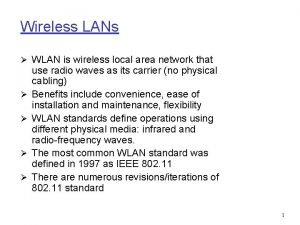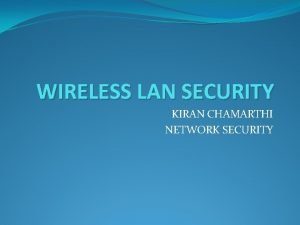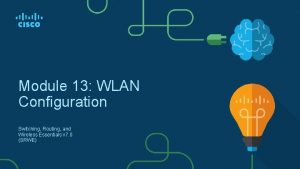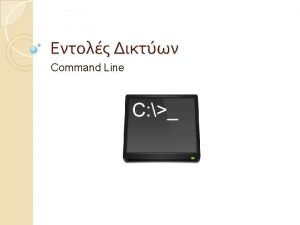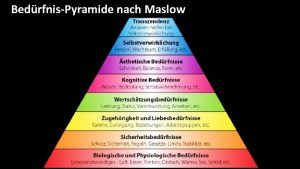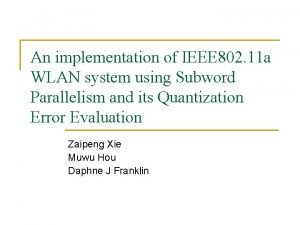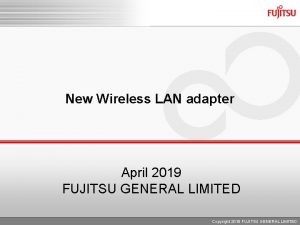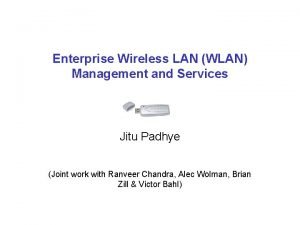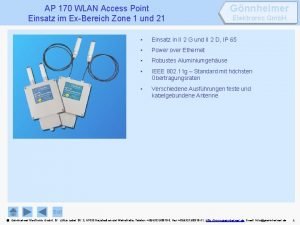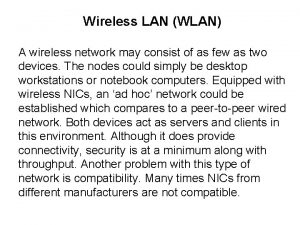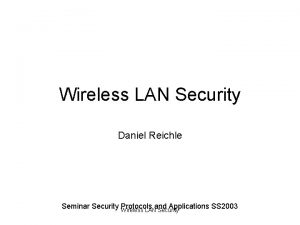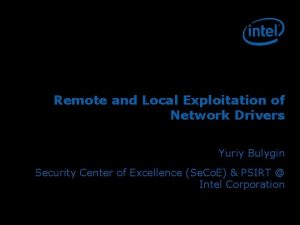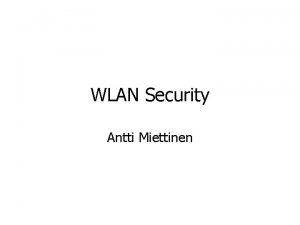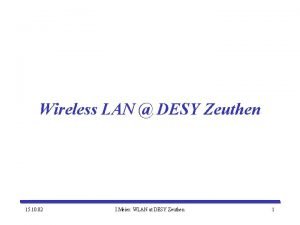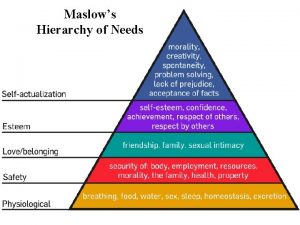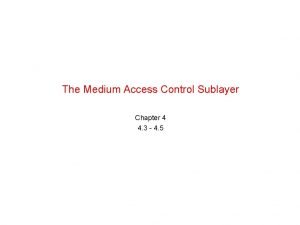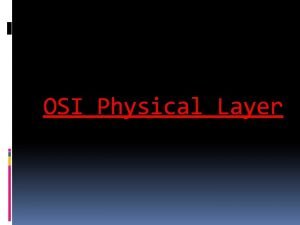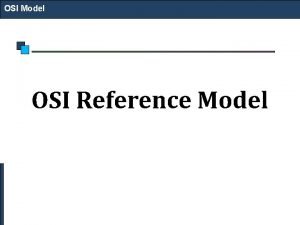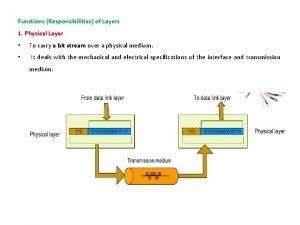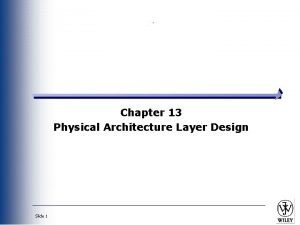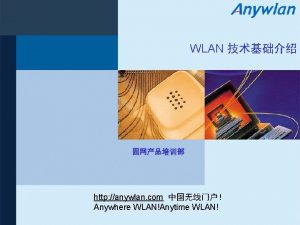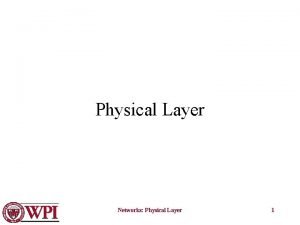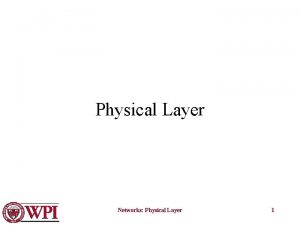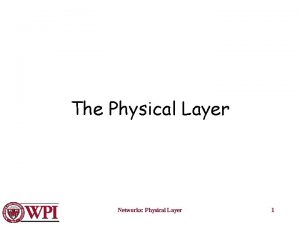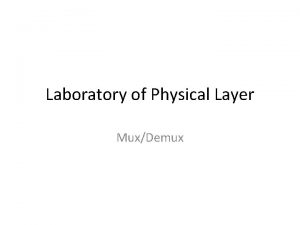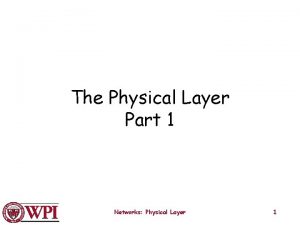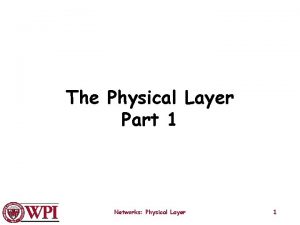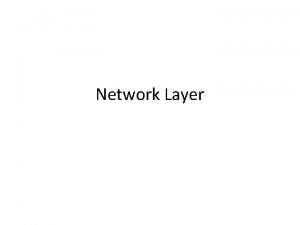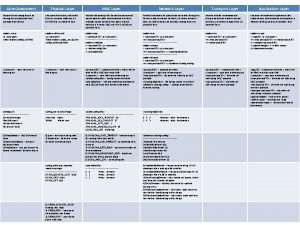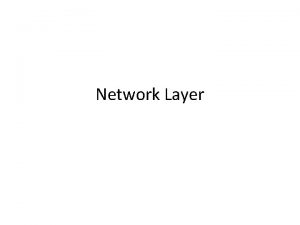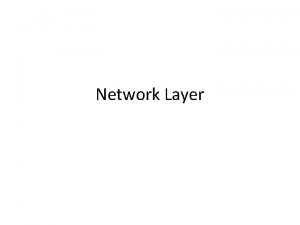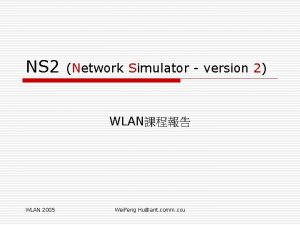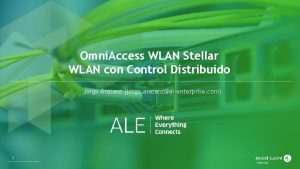WLAN part 3 Contents Physical layer for IEEE











































- Slides: 43

WLAN, part 3 Contents Physical layer for IEEE 802. 11 b • Channel allocation • Modulation and coding • PHY layer frame structure Physical layer for IEEE 802. 11 a/g • Channel allocation • Modulation and coding • OFDM basics • PHY layer frame structure S-72. 3240 Wireless Personal, Local, Metropolitan, and Wide Area Networks 1

WLAN, part 3 Physical layer (PHY) IEEE 802. 11 (in 1999) originally defined three alternatives: DSSS (Direct Sequence Spread Spectrum), FHSS (Frequency Hopping) and IR (Infrared). However, the 802. 11 PHY never took off. : 802. 11 b defines DSSS operation which builds on (and is backward compatible with) the 802. 11 DSSS alternative. 802. 11 a and 802. 11 g use OFDM (Orthogonal Frequency Division Multiplexing) which is very different from DSSS. S-72. 3240 Wireless Personal, Local, Metropolitan, and Wide Area Networks IP LLC MAC PHY 2

WLAN, part 3 Operating channels for 802. 11 b Channel : Channel 1 2 3 10 11 12 13 2. 412 2. 417 2. 422 : 2. 457 2. 462 2. 467 2. 472 GHz GHz Channel 14 2. 484 GHz (only used in Japan) ISM frequency band: 2. 4 … 2. 4835 GHz Channel spacing = 5 MHz Not all channels can be used at the same time! S-72. 3240 Wireless Personal, Local, Metropolitan, and Wide Area Networks 3

WLAN, part 3 Channels used in different regulatory domains Regulatory domain US (FCC) / Canada France Spain Europe (ETSI) Japan Allowed channels 1 to 11 10 to 13 10 to 11 1 to 13 14 Most 802. 11 b products use channel 10 as the default operating channel S-72. 3240 Wireless Personal, Local, Metropolitan, and Wide Area Networks 4

WLAN, part 3 Energy spread of 11 Mchip/s sequence Power 0 d. Br Main lobe Sidelobes -30 d. Br -50 d. Br -22 -11 +22 Center frequency S-72. 3240 Wireless Personal, Local, Metropolitan, and Wide Area Networks Frequency (MHz) 5

WLAN, part 3 Channel separation in 802. 11 b networks 3 channels can be used at the same time in the same area Power 25 MHz Channel 1 Channel 6 Channel 11 Frequency More channels at the same time => severe spectral overlapping S-72. 3240 Wireless Personal, Local, Metropolitan, and Wide Area Networks 6

WLAN, part 3 Bit rates and modulation in 802. 11 b Modulation Bit rate DBPSK DQPSK CCK 1 Mbit/s 2 Mbit/s 5. 5 Mbit/s 11 Mbit/s DB/QPSK = Differential Binary/Quaternary PSK CCK = Complementary Code Keying Defined in 802. 11 b Automatic fall-back to a lower bit rate if channel becomes bad S-72. 3240 Wireless Personal, Local, Metropolitan, and Wide Area Networks 7

WLAN, part 3 Encoding with 11 -chip Barker sequence (Used only at 1 and 2 Mbit/s, CCK is used at higher bit rates) Bit sequence 0 bit 1 bit Barker sequence Transmitted chip sequence S-72. 3240 Wireless Personal, Local, Metropolitan, and Wide Area Networks 8

WLAN, part 3 Differential quadrature phase shift keying (Used at the higher bit rates in one form or another) QPSK symbols in the complex plane: Im p/2 p 3 p/2 0 Re DQPSK encoding table Bit pattern 00 01 11 10 Phase shift w. r. t. previous symbol 0 p/2 p 3 p/2 S-72. 3240 Wireless Personal, Local, Metropolitan, and Wide Area Networks 9

WLAN, part 3 Why 1 or 2 Mbit/s ? Chip rate = 11 Mchips/s Duration of one chip = 1/11 ms Duration of 11 chip Barker code word = 1 ms Code word rate = 1 Mwords/s Each code word carries the information of 1 bit (DBPSK) or 2 bits (DQPSK) => Bit rate = 1 Mbit/s (DBPSK) or 2 Mbit/s (DQPSK) S-72. 3240 Wireless Personal, Local, Metropolitan, and Wide Area Networks 10

WLAN, part 3 802. 11 b transmission at 5. 5 Mbit/s 4 bit block CCK operation . . Initial QPSK phase shift . . Bit sequence One of 22 = 4 8 -chip code words Transmitted 8 -chip code word Code word repetition rate = 1. 375 Mwords/s S-72. 3240 Wireless Personal, Local, Metropolitan, and Wide Area Networks 11

WLAN, part 3 Why 5. 5 Mbit/s ? Chip rate = 11 Mchips/s (same as in IEEE 802. 11) Duration of one chip = 1/11 ms Duration of 8 chip code word = 8/11 ms Code word rate = 11/8 Mwords/s = 1. 375 Mwords/s Each code word carries the information of 4 bits => Bit rate = 4 x 1. 375 Mbit/s = 5. 5 Mbit/s S-72. 3240 Wireless Personal, Local, Metropolitan, and Wide Area Networks 12

WLAN, part 3 802. 11 b transmission at 11 Mbit/s 8 bit block CCK operation . . Initial QPSK phase shift . . Bit sequence One of 26 = 64 8 -chip code words Transmitted 8 -chip code word Code word repetition rate = 1. 375 Mwords/s S-72. 3240 Wireless Personal, Local, Metropolitan, and Wide Area Networks 13

WLAN, part 3 Why 11 Mbit/s ? Chip rate = 11 Mchips/s (same as in IEEE 802. 11) Duration of one chip = 1/11 ms Duration of 8 chip code word = 8/11 ms Code word rate = 11/8 Mwords/s = 1. 375 Mwords/s Each code word carries the information of 8 bits => Bit rate = 8 x 1. 375 Mbit/s = 11 Mbit/s S-72. 3240 Wireless Personal, Local, Metropolitan, and Wide Area Networks 14

WLAN, part 3 IEEE 802. 11 b frame structure (PHY layer) PPDU (PLCP Protocol Data Unit) 128 scrambled 1 s 16 8 8 16 16 bits PLCP Preamble Payload (MPDU) PLCP header PHY header 1 Mbit/s DBPSK (In addition to this ”long” frame format, there is also a ”short” frame format) 1 Mbit/s DBPSK 2 Mbit/s DQPSK 5. 5/11 Mbit/s CCK S-72. 3240 Wireless Personal, Local, Metropolitan, and Wide Area Networks 15

WLAN, part 3 IEEE 802. 11 b frame structure : IP packet H MAC H LLC payload MSDU (MAC SDU) MAC MPDU (MAC Protocol Data Unit) PHY H PSDU (PLCP Service Data Unit) PHY PPDU (PLCP Protocol Data Unit) S-72. 3240 Wireless Personal, Local, Metropolitan, and Wide Area Networks 16

WLAN, part 3 IEEE 802. 11 a/g This physical layer implementation is based on OFDM (Orthogonal Frequency Division Multiplexing). The information is carried over the radio medium using orthogonal subcarriers. A channel (16. 25 MHz wide) is divided into 52 subcarriers (48 subcarriers for data and 4 subcarriers serving as pilot signals). Subcarriers are modulated using BPSK, QPSK, 16 -QAM, or 64 -QAM, and coded using convolutional codes (R = 1/2, 2/3, and 3/4), depending on the data rate. S-72. 3240 Wireless Personal, Local, Metropolitan, and Wide Area Networks 17

WLAN, part 3 Frequency domain Presentation of subcarriers in frequency domain: 52 subcarriers 16. 25 MHz Frequency By using pilot subcarriers (-21, -7, 7 and 21) as a reference for phase and amplitude, the 802. 11 a/g receiver can demodulate the data in the other subcarriers. S-72. 3240 Wireless Personal, Local, Metropolitan, and Wide Area Networks 18

WLAN, part 3 Time domain Presentation of OFDM signal in time domain: Guard time for preventing intersymbol interference 0. 8 ms In the receiver, FFT is calculated only during this time 3. 2 ms Next symbol Time 4. 0 ms Symbol duration S-72. 3240 Wireless Personal, Local, Metropolitan, and Wide Area Networks 19

WLAN, part 3 Subcarrier modulation and coding Modulation Bit rate Coding rate Coded bits / symbol Data bits / symbol BPSK QPSK 16 -QAM 64 -QAM 6 Mbit/s 9 Mbit/s 12 Mbit/s 18 Mbit/s 24 Mbit/s 36 Mbit/s 48 Mbit/s 54 Mbit/s 1/2 3/4 2/3 3/4 48 48 96 96 192 288 24 36 48 72 96 144 192 216 S-72. 3240 Wireless Personal, Local, Metropolitan, and Wide Area Networks 20

WLAN, part 3 Bit-to-symbol mapping in 16 -QAM Gray bit-to-symbol mapping is usually used in QAM systems. The reason: it is optimal in the sense that a symbol error (involving adjacent points in the QAM signal constellation) results in a single bit error. Example for 16 -QAM 0010 0110 1010 0011 0111 1011 0001 0101 1001 0000 0100 1000 S-72. 3240 Wireless Personal, Local, Metropolitan, and Wide Area Networks 21

WLAN, part 3 Why (for instance) 54 Mbit/s ? Symbol duration = 4 ms Data-carrying subcarriers = 48 Coded bits / subcarrier = 6 (64 QAM) Coded bits / symbol = 6 x 48 = 288 Data bits / symbol: 3/4 x 288 = 216 bits/symbol => Bit rate = 216 bits / 4 ms = 54 Mbit/s S-72. 3240 Wireless Personal, Local, Metropolitan, and Wide Area Networks 22

WLAN, part 3 Orthogonality between subcarriers (1) Orthogonality over this interval Subcarrier n+1 Previous symbol Guard time Symbol part that is used for FFT calculation at receiver S-72. 3240 Wireless Personal, Local, Metropolitan, and Wide Area Networks Next symbol 23

WLAN, part 3 Orthogonality between subcarriers (2) Orthogonality over this interval Subcarrier n Each subcarrier has an integer number of cycles in the FFT calculation interval (in our case 3 and 4 Subcarrier cycles). n+1 If this condition is valid, the spectrum of a subchannel contains spectral nulls at all other subcarrier frequencies. Previous symbol Guard time Symbol part that is used for FFT calculation at receiver S-72. 3240 Wireless Personal, Local, Metropolitan, and Wide Area Networks Next symbol 24

WLAN, part 3 Orthogonality between subcarriers (3) Orthogonality over the FFT interval (TFFT): Phase shift in either subcarrier - orthogonality over the FFT interval is still retained: S-72. 3240 Wireless Personal, Local, Metropolitan, and Wide Area Networks 25

WLAN, part 3 Time vs. frequency domain TG TFFT Square-windowed sinusoid in time domain => "sinc" shaped subchannel spectrum in frequency domain S-72. 3240 Wireless Personal, Local, Metropolitan, and Wide Area Networks 26

WLAN, part 3 Subchannels in frequency domain Single subchannel OFDM spectrum Subcarrier spacing = 1/TFFT Spectral nulls at other subcarrier frequencies S-72. 3240 Wireless Personal, Local, Metropolitan, and Wide Area Networks 27

WLAN, part 3 Presentation of OFDM symbol In an OFDM symbol sequence, the k: th OFDM symbol (in complex low-pass equivalent form) is where N = number of subcarriers, T = TG + TFFT = symbol period, and an, k is the complex data symbol modulating the n: th subcarrier during the k: th symbol period. S-72. 3240 Wireless Personal, Local, Metropolitan, and Wide Area Networks 28

WLAN, part 3 Multipath effect on subcarrier n (1) Subcarrier n Delayed replicas of subcarrier n Previous symbol Guard time Symbol part that is used for FFT calculation at receiver S-72. 3240 Wireless Personal, Local, Metropolitan, and Wide Area Networks Next symbol 29

WLAN, part 3 Multipath effect on subcarrier n (2) Subcarrier n Guard time not exceeded: Delayed multipath replicas do not affect the orthogonality behavior of the subcarrier in. Delayed frequency domain. replicas of subcarrier n There are still spectral nulls at other Previoussubcarrier Guardfrequencies. Symbol part that is used for symbol time FFT calculation at receiver S-72. 3240 Wireless Personal, Local, Metropolitan, and Wide Area Networks Next symbol 30

WLAN, part 3 Multipath effect on subcarrier n (3) Subcarrier n Mathematical explanation: Sum of sinusoids (with the same frequency but with different magnitudes and phases) = still a Delayed replicas of subcarrier n pure sinusoid with the same frequency (and with resultant Previous Guard Symbol part that is used for magnitude and phase). symbol time FFT calculation at receiver S-72. 3240 Wireless Personal, Local, Metropolitan, and Wide Area Networks Next symbol 31

WLAN, part 3 Multipath effect on subcarrier n (4) Subcarrier n Replicas with large delay Previous symbol Guard time Symbol part that is used for FFT calculation at receiver S-72. 3240 Wireless Personal, Local, Metropolitan, and Wide Area Networks Next symbol 32

WLAN, part 3 Multipath effect on subcarrier n (5) Subcarrier n Guard time exceeded: Delayed multipath replicas affect the orthogonality behavior of the subchannels in frequency domain. Replicas with large delay There are no more spectral nulls at other subcarrier frequencies => this Previous Guard Symbol part that is used for causes inter-carrier interference. symbol time FFT calculation at receiver S-72. 3240 Wireless Personal, Local, Metropolitan, and Wide Area Networks Next symbol 33

WLAN, part 3 Multipath effect on subcarrier n (6) Subcarrier n Mathematical explanation: Strongly delayed multipath replicas are no longer pure sinusoids! Replicas with large delay Previous symbol Guard time Symbol part that is used for FFT calculation at receiver S-72. 3240 Wireless Personal, Local, Metropolitan, and Wide Area Networks Next symbol 34

WLAN, part 3 IEEE 802. 11 a in Europe 802. 11 a was designed in the USA. In Europe, a similar WLAN system – Hiper. LAN 2 – was designed by ETSI (European Telecommunications Standards Institute), intended to be used in the same frequency band (5 GHz). Although Hiper. LAN 2 has not (yet) took off, 802. 11 a devices, when being used in Europe, must include two Hiper. LAN 2 features not required in the USA: • DFS (Dynamic Frequency Selection) • TPC (Transmit Power Control) S-72. 3240 Wireless Personal, Local, Metropolitan, and Wide Area Networks 35

WLAN, part 3 IEEE 802. 11 g PHY 802. 11 g is also based on OFDM (and same parameters as 802. 11 a). However, 802. 11 g uses the 2. 4 GHz frequency band, like 802. 11 b (usually: dual mode devices). Since the bandwidth of a 802. 11 b signal is 22 MHz and that of a 802. 11 g signal is 16. 25 MHz, 802. 11 g can easily use the same channel structure as 802. 11 b (i. e. at most three channels at the same time in the same area). 802. 11 g and 802. 11 b stations must be able to share the same channels in the 2. 4 GHz frequency band => interworking required. S-72. 3240 Wireless Personal, Local, Metropolitan, and Wide Area Networks 36

WLAN, part 3 IEEE 802. 11 g frame structure (PHY layer) Pad (n bits) SERVICE (16 bits) Tail (6 bits) PHY payload (MAC protocol data unit) PLCP preamble SIGNAL DATA 16 ms 4 ms N. 4 ms 6 Mbit/s 6 … 54 Mbit/s S-72. 3240 Wireless Personal, Local, Metropolitan, and Wide Area Networks 37

WLAN, part 3 IEEE 802. 11 g frame structure PHY layer “steals” bits from first and last OFDM symbol H MAC H : LLC payload MSDU (MAC SDU) MAC MPDU (MAC Protocol Data Unit) PHY H N OFDM symbols (N. 4 ms) PHY PPDU (PLCP Protocol Data Unit) S-72. 3240 Wireless Personal, Local, Metropolitan, and Wide Area Networks 38

WLAN, part 3 IEEE 802. 11 g and 802. 11 b interworking (1) 802. 11 g and 802. 11 b interworking is based on two alternatives regarding the 802. 11 g signal structure: Preamble/Header Payload 802. 11 b DSSS 802. 11 g, opt. 1 DSSS OFDM 802. 11 g, opt. 2 OFDM S-72. 3240 Wireless Personal, Local, Metropolitan, and Wide Area Networks 39

WLAN, part 3 IEEE 802. 11 g and 802. 11 b interworking (2) Option 1 (*): The preamble & PLCP header part of 802. 11 g packets is based on DSSS (using BPSK at 1 Mbit/s or QPSK at 2 Mbit/s), like 802. 11 b packets. 802. 11 g and 802. 11 b stations compete on equal terms for access to the channel (CSMA/CA). However, the 802. 11 g preamble & header is rather large (compared to option 2). 802. 11 g, opt. 1 802. 11 g, opt. 2 DSSS OFDM (*) called DSSS-OFDM in the 802. 11 g standard S-72. 3240 Wireless Personal, Local, Metropolitan, and Wide Area Networks 40

WLAN, part 3 IEEE 802. 11 g and 802. 11 b interworking (3) Option 2 (*): The preamble & header of 802. 11 g packets is based on OFDM (using BPSK at 6 Mbit/s). Now, 802. 11 b stations cannot decode the information in the 802. 11 g packet header and the CSMA/CA scheme will not work properly. Solution: Stations should use the RTS/CTS mechanism before transmitting a packet. 802. 11 g, opt. 1 802. 11 g, opt. 2 DSSS OFDM (*) called ERP-OFDM (ERP = Extended Rate PHY) in the 802. 11 g standard S-72. 3240 Wireless Personal, Local, Metropolitan, and Wide Area Networks 41

WLAN, part 3 IEEE 802. 11 a/g DSSS-OFDM option DSSS header = 144+48 bits = 192 ms (long preamble) DSSS header = 96 ms (short preamble) Interoperability with 802. 11 b, option 1 Data frame ACK frame Backoff DIFS SIFS DIFS S-72. 3240 Wireless Personal, Local, Metropolitan, and Wide Area Networks Next data frame 42

WLAN, part 3 IEEE 802. 11 a/g ERP-OFDM option OFDM header = 20 ms No interoperability with 802. 11 b (or use RTS/CTS mechanism) Data frame ACK frame Backoff DIFS SIFS DIFS Next data frame S-72. 3240 Wireless Personal, Local, Metropolitan, and Wide Area Networks 43
 Fig 19
Fig 19 Chemical digestion
Chemical digestion Secure socket layer and transport layer security
Secure socket layer and transport layer security Presentation layer functions
Presentation layer functions Secure socket layer and transport layer security
Secure socket layer and transport layer security Secure socket layer and transport layer security
Secure socket layer and transport layer security Secure socket layer and transport layer security
Secure socket layer and transport layer security Layer 2 e layer 3
Layer 2 e layer 3 Layer-by-layer assembly
Layer-by-layer assembly Layer 2 vs layer 3 bitstream
Layer 2 vs layer 3 bitstream Wlan architecture
Wlan architecture Wlan topology
Wlan topology Wireless security definition
Wireless security definition Packet tracer - wlan configuration
Packet tracer - wlan configuration Uniaccount freiburg
Uniaccount freiburg Netsh wlan show profiles
Netsh wlan show profiles Maslow pyramide
Maslow pyramide Wlan 802
Wlan 802 Wwan wlan
Wwan wlan Fujitsu uty-tfsxf1
Fujitsu uty-tfsxf1 High efficiency wlan
High efficiency wlan Lan/wlan services
Lan/wlan services Wlan exit point
Wlan exit point B m informatik
B m informatik Wlan filtreleme nedir
Wlan filtreleme nedir Meinziv wwu
Meinziv wwu Wlan
Wlan What does a wireless lan (wlan) act as to a wired network?
What does a wireless lan (wlan) act as to a wired network? Wlan wep
Wlan wep Ieee802.22
Ieee802.22 Fuzzing wlan
Fuzzing wlan Junos space cross provisioning platform spec
Junos space cross provisioning platform spec What is wlan
What is wlan Desy wlan
Desy wlan Maslow pyramide wlan
Maslow pyramide wlan Biological needs
Biological needs All mammals have hair. its main purpose is to
All mammals have hair. its main purpose is to Classic ethernet mac sublayer protocol
Classic ethernet mac sublayer protocol What is the purpose of the osi physical layer
What is the purpose of the osi physical layer Osi reference model diagram
Osi reference model diagram Functions of physical layer
Functions of physical layer Physical architecture layer design
Physical architecture layer design Physical architecture layer design
Physical architecture layer design Physical layer transmission media
Physical layer transmission media










